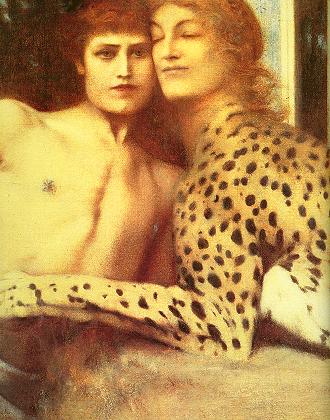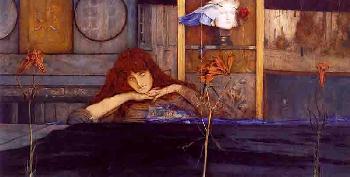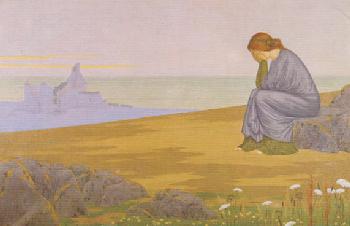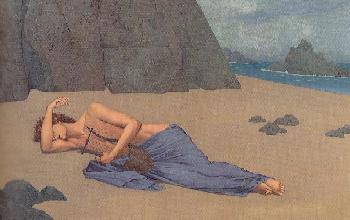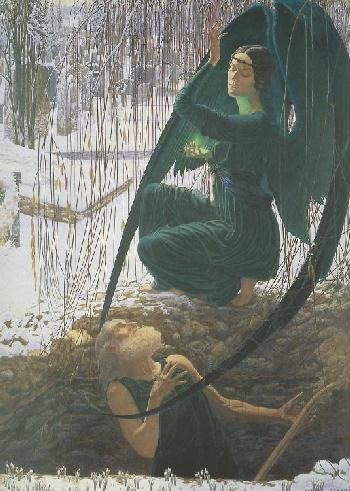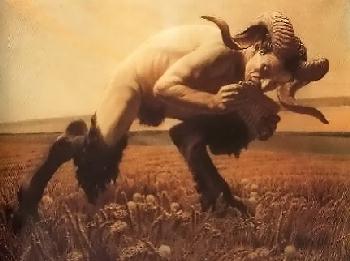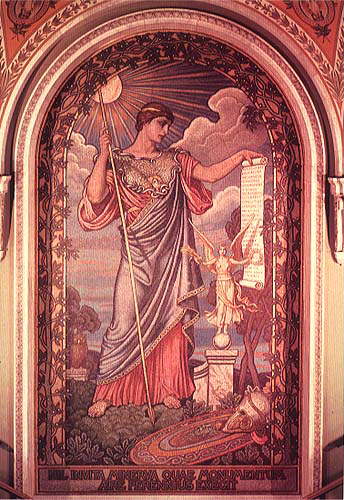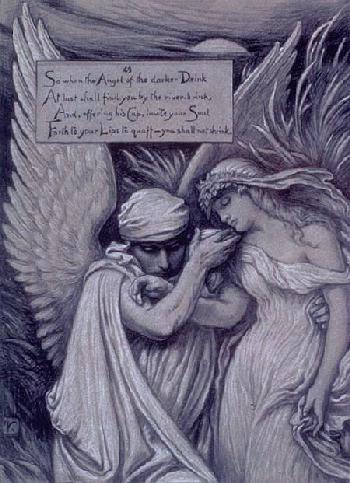| Salon de la Rose-Croix
The Art History Archive - French Art
Art Movement or Art Cult?
Right: Fernand Khnopff - Art Sphinx A resurgence of Catholicism in France amongst painters and writers caused some artists to form religious cults. One such cultic group was the Mystic Order of the Rose+Croix. Founded by Josephin Peladan (1859-1918) the Salon aspect of Rosicrucianism promotes the arts, has an esoteric flavour and combines communist beliefs. Peladan "ordered" that only subjects inspired by religion, mysticism, legend and myth, dream, allegory and poetry was worthy to be in his Salons. Scenes of landscapes, modern life, were prohibited in his art galleries. His followers included: Edmon Aman-Jean, Jean Delville, Charles Filiger, Armand Point, Carlos Schwabe and Alexandre Seon. From Delville's satanic imagery to Schwabe's Catholicism, the group covered a broad religious/gothic genre, and could be considered to be a predecessor for the Neo-Gothic Art Movement. The group hosted six salons from 1892 to 1897. The first show contained a performance from one of Peladan's plays and music by Erik Satie, Giovanni Pierluigi da Palestrina and Wagner. The shows were considered to be spectacles and thus attracted a wide audience. Right: Fernand Khnopff - Unknown Peladan eventually went bankrupt and disbanded the group, but during his brief fame the salons showed the work of 230 different artists. The group is often considered to be part of the Symbolist movement, despite the fact that some of the pieces aren't really symbolist. Rosicrucianism is still around today, but it is basically a cult/scam to suck money out of artists. The original Rosicrucianism was founded by Christian Rosenkrutz (a person some historians claim never existed but is himself a fictional creation). Traditionally and historically, the Rosicrucian movement has always fought for the establishment and perpetuation of freedom – the freedom of mind, spirit, and soul, but these are simply words to suck in gullible artists. Today more emphasis is being put into attracting scientists to the group. THE AUTHOR OF THIS WEBSITE WOULD LIKE TO WARN PEOPLE TO STAY AWAY FROM ROSICRUCIANISM AND PEOPLE WHO CLAIM TO BE ROSICRUCIANS. IT IS A DANGEROUS CULT. But regardless of its current danger, the group did create quite a few art pieces of note during the late 1800s. I have included ELIHU VEDDER below because of his similarity to the group, but stress that he is not actually a member of the Salon de la Rose-Croix.
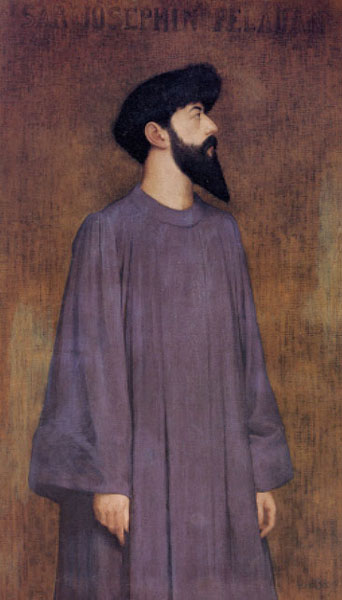
Alexandre Seon - Portrait of Josephin Peladan, 1891
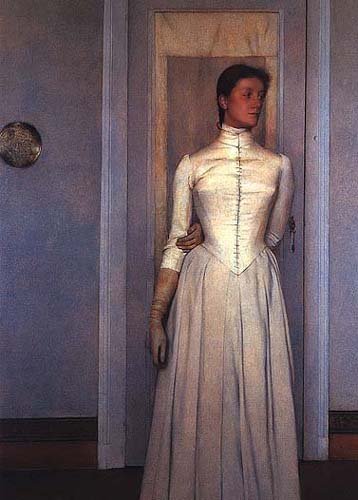
Fernand Khnopff - Portrait of Marguerite Khnopff, 1887
ALEXANDRE SEON (1855-1917)French illustrator and decorator and one of the major disciples of Puvis de Chavannes. After studying at the Beaux-Arts of Lyon and Paris (where he studied with Lehmann), Séon in 1891 became Puvis de Chavanne's student and then his collaborator. With Péladan and Antoine de la Rochefoucauld, he was one of the founders of the Rose+Croix Salon, where he often exhibited to considerable praise from the Symbolist critics.
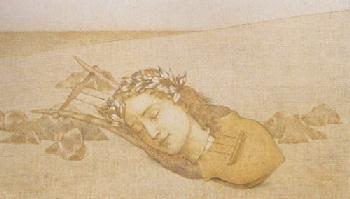
Alexandre Seon - The Lyre of Orpheus, 1898
CARLOS SCHWABE (1866-1926)Carlos Schwabe was born in Germany in 1866 and raised in Geneva, Switzerland. In 1890 he visited Paris and met Joseph Péladan, who noticed one of his first paintings, The Evening Bells. Péladan entrusted Schwabe with the task of designing the poster for the first Salon de la Rose+Croix. The poster, which shows two women climbing stairs that lead to the ideal, while a third figure, mired in materialism, looks on helplessly, contributed significantly to the success of the show. Although Schwabe exhibited at only one of Péladan's salons, he placed his considerable gifts as a draftsman in the service of Symbolist literature and composed remarkable drawings; many of them enhanced with watercolors, for volumes of poetry by Baudelaire (Flowers of Evil), Stéphane Mallarmé (The Afternoon of a Faun) and many other poets of the Symbolist era. He was described by critics as “ the most astonishing designer for books, whose decorative work is like a piece of embroidery; he hems it with an appropriate motif and covers the entire page with random design”. Schwabe is best known for his masterpiece “The Death of the Grave-Digger” (1895), depicting an angel of death with long green scythe-like wings who comes to claim the life of an old man who is digging a grave in a snowy cemetery. Death is portrayed as a beautiful woman (his own wife) who sits like a great bird aside the grave. The wings appear to caress and soothe the old man, while she holds a dim glow in the palm of her hand, representing the life transcending to the other world. The painting is a Symbolist movement classic, as it uses the entire Symbolist repertory of signs and plants. The critic for Art et Décoration compared Schwabe to Durer and wrote: ‘In the reverberation of his faculties, all of which are excited at the same time, the reflections of tragic, bizarre and mysterious dreams are mixed under the artist’s fingers, in which one deciphers the symbolic signs of confused destinies and, at the same time, infinitely touching refinements of feeling’.
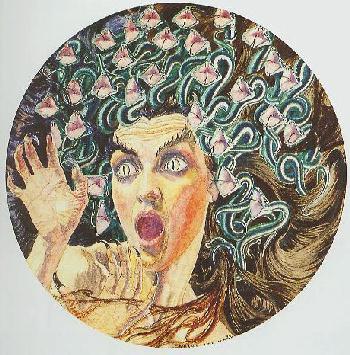
Carlos Schwabe - Medusa, 1895 OTHER WORKS BY CARLOS SCHWABE: |
||||
|
ELIHU VEDDER (1826-1923)Right: Elihu Vedder - Minerva Born in New York City, Elihu Vedder was known as a painter of many esoteric subjects and was a leading symbolist painter whose post-Civil War work evokes melancholy and tragedy. He spent his youth in Schenectady, New York, studied art in New York City under the genre painter Tomkins H. Matteson, then studied in Paris for a few months in 1856 under Picot, and finally in Florence, Italy under Raffaelle Bonaiuti. Penniless, he returned to New York at the start of the Civil War (1861) and turned to commercial art, drawing sketches for "Vanity Fair" and diagrams for instructing people in the use of dumbbells. At the end of the war, he left the United States and spent the remaining fifty-eight years of his life in Europe, primarily Rome and the Island of Capri. For the rest of his life he traveled frequently in Europe and back to America. Elihu Vedder’s realist pictures showing classical, mythological and ideal scenes, seem to be very similar to British Victorian artists, Pre-Raphaelites and Symbolists painters. Vedder's work has a power of evocation, which is reminiscent of the symbolist artist Odilon Redon. Vedder had a strong taste for the mystical and the occult, starting with work of the 1860s such as Lair of the Sea Serpent (1864). In the 1870s he traveled several times to London where he met Alma-Tadema and Lord Leighton, much of his work thereafter is in this vein. Particularly notable in this respect are compositions such as Rome, Representative of the Arts, a semicircular work similar to Leighton's The Arts of Peace. Vedder traveled in Egypt in 1889-90, and produced various landscapes and Oriental works then and later. Vedder worked on line illustrations from the 1860s, when he found difficulty supporting himself in New York as a painter of then-unfashionable topics. He continued with illustrative work even after he established himself, including pictures to accompany his own poetry. Right: Elihu Vedder - The Cup of Death, 1883-1884 In 1884, he published his major work, over 50 illustrations for "The Rubaiyat of Omar Khayyam". These illustrations set high standards for artist designed books. He created designs for the entire book and included intriguing drawings and hand-drawn letters. Based on the poetry of a Persian mathematician and originally written about 1120 A.D., the work had been translated in the 19th century by an Englishman, Edward Fitzgerald, and had become treasured for its spiritual and poetic writing by aesthetes including Vedder. Many of the drawings in that volume were reproduced in art journals, or as engravings - perhaps the most familiar are The Throne of Saturn, The Cup of Death, and The Pleiades. His new fame as an illustrator found him a place in Edgar Allan Poe's "The Raven", alongside Gustav Dore. The artist's own life had instances of life and death that paralleled Khayyam's message of fate, death, and renewal of life. In 1872, his infant son died, and the following year a daughter was born. His first-born son died in 1875, and another son was born that same year. Vedder described the Rubáiyát as 'a poem so much in harmony with my thought'. In the 1890s, Vedder carried out various murals during trips to America, most notably 5 murals for the Reading Room Library of Congress in Washington, murals for the Huntington Mansion, New York (1892-4), and those at the Walter Art Building, Bowdoin College, Maine (1894). After 1901 he remained in Italy, publishing his memoirs, The Digressions of V, in 1910. Vedder's compositions and ideas are excellent and bold. He has an interest in drapery perhaps most similar to that of Burne-Jones. Works by Vedder appear in England occasionally in loan exhibitions. His paintings are to be found in American museums. The Chicago Art Institute has Fates Gathering the Stars and A Glimpse of Hell or Fear. Lair of the Sea Serpent and The Questioner of the Sphinx are in the Museum of Fine Arts, Boston, and The Roc's Egg is in the Chrysler Museum, Norfolk, Virginia. A medieval genre painting, Music Party, is in the Springfield Museum of Fine Arts, and among his various landscapes, an excellent Egyptian Landscape is in the Phoenix Art Museum, Arizona.
|
||||
